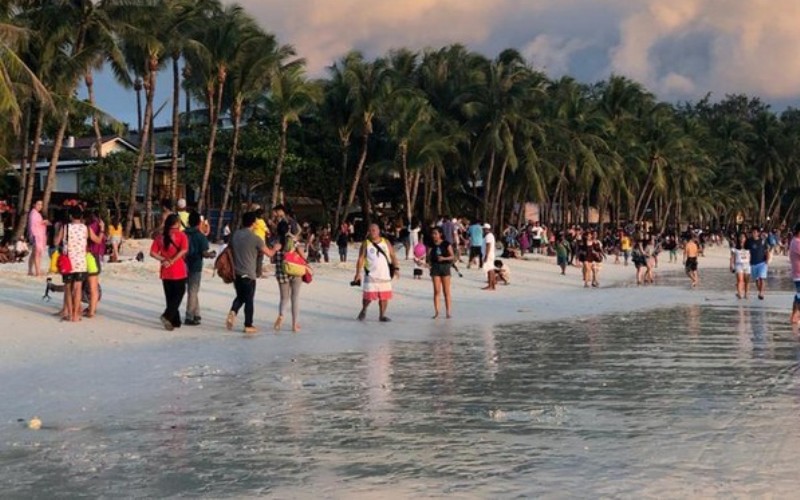Singapore: In February this year, Philippine President Rodrigo Duterte declared the world-famous island resort of Boracay a “cesspool”. True to his all-action image, shortly after his comments, Duterte ordered the resort island closed for tourists from April 26.
The environment ministry said back then that 195 businesses and 4,000 residential customers were not connected to sewer lines. Many of them were dumping their untreated waste straight into the surrounding turquoise waters. This is on-top of various building-code violations.
Actually, it was worse. In May, out of a total of 1,552 establishments inspected, it was found that only 38 were in compliance with government regulations. Out of this, 500 were hotels.
Tourists and the hospitality industry alike complained about the sudden and drastic action. Others were worried about how this would affect the livelihoods of about 28,000 people employed by the tourism-related services and construction industries. This is not counting the numerous unlicensed vendors and service providers who depended on tourists for income. 2017 tourism receipts in Boracay totalled US$1 billion a year and it had over 2 million visitors.
The shut-down was enforced by suspending flights, ferry services, making beaches off-limits, closing hotels and other businesses that were not complying with environmental, health and safety guidelines.
Boracay is a 10 square kilometres tropical paradise island renowned for its pristine white sandy beaches and crystal-clear waters as well as its beach party culture. It has won many awards from travel publications for its idyllic serenity juxtaposed against an electrifying nightlife.
As promised, six months after its closure, beginning October 26, a small number of visitors were allowed back onto the island to enjoy its newly restored beaches and water.This number would gradually be increased.
In order to ensure sustainability and preservation of the natural beauty of this stunning island,new measures were introduced by the government. Among them is a limit of no more than 19,000 visitors at any one time. Visitors are also only allowed to book accommodation with accredited hotels. Smoking, drinking, eating and hawking will also be prohibited on the beaches, so visitors are able to relax and enjoy a quiet day in a clean, litter-free environment. Another sustainability measure is the banning of open fires and the use of kerosene and gas lamps.It looks like there will be no more fire dancing and wild partying on the beaches.
As of November 26, the Department of Tourism (DOT) announced that they have accredited a total of 243 hotels with a total of 9,248 rooms. Prior to the reopening, only 25 accommodations with 2,063 rooms were accredited.
Tourism accounts for 10 per cent of GDP in the Philippines. Under the National Tourism Development Plan, the government is targeting 12 million inbound visitors in 2022. The number of foreign visitors is projected to reach 7.1 million this year.
Tourism stakeholders in the Philippines have always been keen to increase arrivals from India, saying it’s a promising market with huge growth potential and can contribute significantly to country’s tourism sector in years to come.
Indians form only the 12th largest group of visitors to the Philippines. The top 3 visitors are from South Korea, China and the United States, respectively. The Chinese are the fastest growing group of visitors with a growth rate of 30-40 per cent in the last two years. At this rate, it will overtake South Korea within 3 years.
Despite the lack of direct air connections between India and Philippines, Indians represent the second fastest growing group ofarrivals with an annual growth rate of around 15-18 per cent in the last two years, albeit with a low base compared with the Chinese. China is projected to have 1.3 million visitors in 2018 whereas India 125,000.
The most common way of getting to the Philippines is to make a transit stop in Singapore. To boost arrivals to the Philippines, in December 2017, the DOT signed a one-year partnership with Singapore Airlines (SIA) to implement joint marketing activities to promote the Philippines to the Indian market. Activities included the use of various marketing platforms such as social media, familiarisation tours and roadshows.
The DOT added that SIA and its sister company, SilkAir, also agreed to bring tourists not only to Manila but also to secondary destinations, in keeping with Tourism Secretary Wanda Corazon T. Teo’s policy of encouraging tourists to visit key destinations outside Metro Manila.
Although direct flights between major cities in India and the Philippines were expected by the end of this year, this has not materialised. At the moment Indians require a visa to enter the Philippines. However, since 2015 Indian nationals who already have visas from the United States, Japan, Australia, Canada, Singapore, UK and the Schengen area (for Europe) can apply for a visa-on-arrival for an initial stay of 14 days. The DOT continues to appeal to the Department of Justice to grant visa-on-arrival privilege to all Indian tourists without exception.
Boracay is but one of several exciting destinations in the Philippines. The other popular places worth considering a visit are Palawan, Cebu, Luzon and capital city Manila.
[source_without_link]ANI[/source_without_link]

